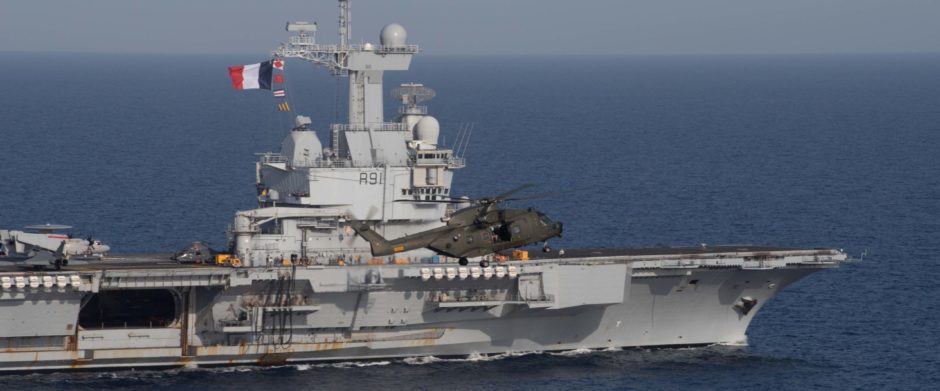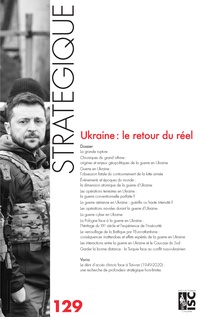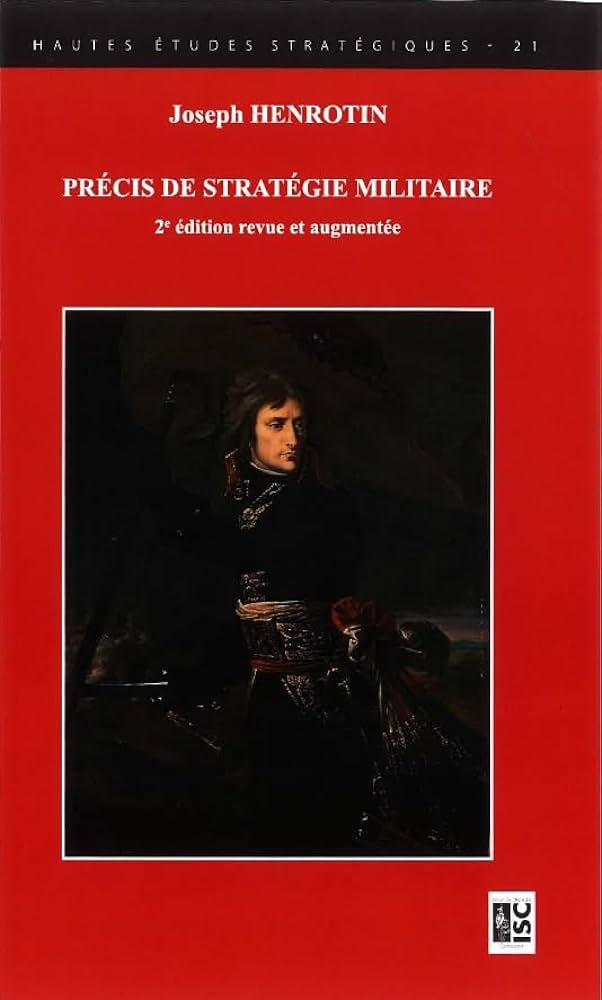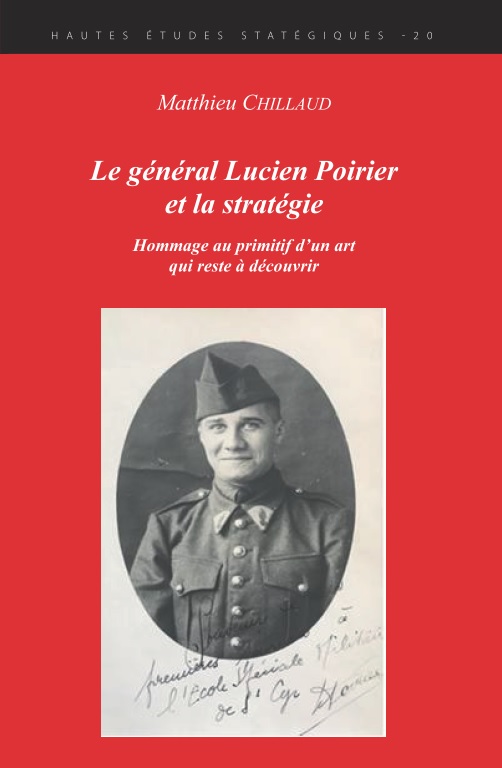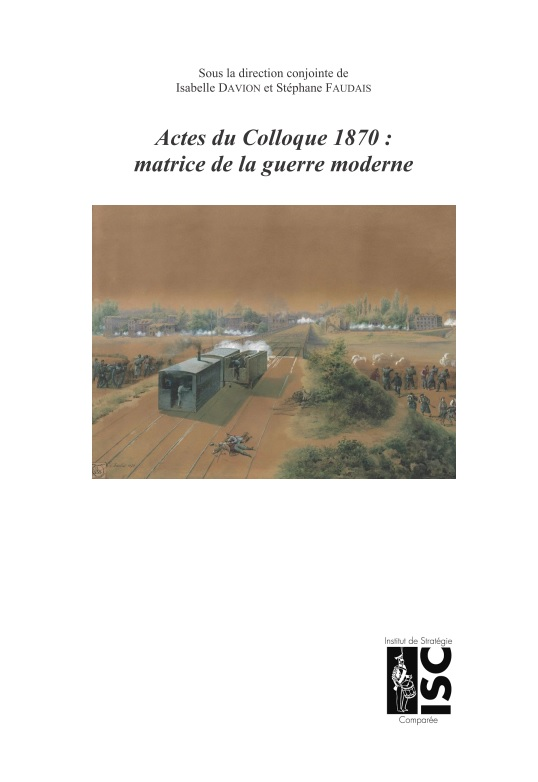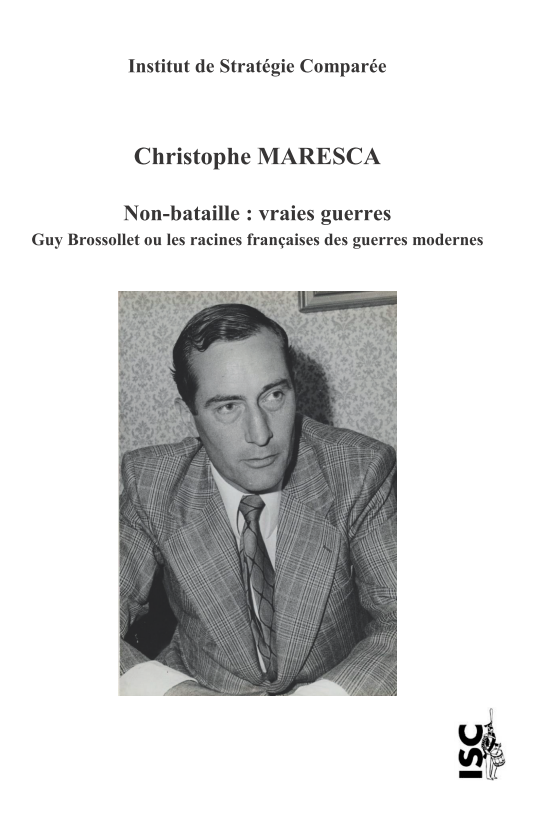- Anonyme, De l’Esprit militaire, La Haye, 2e éd. 1785.
- Bacon (comte de), Manuel du jeune officier ou essai de théorie militaire, Paris, Chez Jombert jeune, 1782.
- Bülow Dietrich von, L’esprit du système de guerre moderne, Paris, Chez Magimel, Anselin et Pochard, 1801, rééd. précédée de Jean-Jacques Langendorf, Bülow stratège de la Révolution et de la certitude, Paris, ISC-Économica, 2012.
- Comeau (général baron de), Souvenirs des campagnes d’Allemagne pendant les guerres de la Révolution et de l’Empire, Paris, Plon, 1900.
- Commentaires de Napoléon Ier, 6 vol., Paris, Imprimerie impériale, 1867.
- Correspondance de Napoléon. Six cents lettres de travail 1806-1810, Paris, Gallimard, 1943.
- Correspondance militaire de Napoléon, 10 vol., Paris, Plon, 1877 ; en cours de remplacement par la Correspondance de Napoléon, publiée par la Fondation Napoléon, Paris, Fayard, 7 vols parus.
- Feuquière (marquis de), Mémoires de M. le marquis de Feuquière, Londres, Chez Pierre Dunoyer, 1736.
- Frederick the Great on the Art of War, ed. and trans. by Jay Luvaas, New York, The Free Press, 1966 (en français, en l’absence d’édition récente, il faut recourir à Liskenne et Sauvan).
- Guibert, Stratégiques, Paris, l’Herne, Classiques de la stratégie, 1977.
- Guibert, Œuvres militaires, publiées par sa veuve, Paris, Chez Magimel, 5 vol., An XII-1803.
- Joly de Maizeroy, Théorie de la guerre, Nancy, Chez la Veuve Leclerc, 1777.
- Le Opere di Raimondo Montecucculi, édités par Raimondo Luraghi, Rome, Stato maggiore dell esercito. Ufficio storico, 3 vol., 1988-2001.
- Le Roy de Bosroger, Elémens de la guerre, Paris, Chez J. P. Costard, 1773.
- Le Vasseur, Commentaires de Napoléon, Paris, Corréard, 1851.
- Lederer L. (ed.), Joseph de Maistre, Paris, Berger-Levrault, Les Classiques de l’art militaire, 1949.
- Lloyd Henry, Histoire des guerres d’Allemagne, Paris, ISC-Économica, Bibliothèque stratégique, 2001.
- Machiavel Nicolas, Oeuvres complètes, Paris, Gallimard, Bibliothèque de la Pléiade, 1952.
- Montecucculi, Mémoires de Montecucculi, avec les Commentaires du Comte Turpin de Crissé, Paris, Chez C.A. Jombert, 1770.
- Nachin Lucien, Blaise de Monluc, Paris, Berger-Levrault, Les Classiques de l’art militaire, 1949.
- Nockern de Schorn François, Idées raisonnées sur un système général et suivi de toutes les connaissances militaires et sur une méthode lumineuse pour étudier la science de la guerre avec ordre et discernement, Nuremberg et Altdorf, chez George Pierre Monath, 1780 (réédition en cours).
- [Prince de Ligne], Préjugés militaires, À Kravelhota, 1780.
- [Prince de Ligne], Fantaisies militaires, À Kravelhota, 1780.
- Prince de Ligne, Catalogue de ma bibliothèque militaire, préface de Bruno Colson, Paris, ISC, 2012.
- Puységur (maréchal de), Art de la guerre par principes et par règles, Paris, Chez C.A. Jombert, 1748.
- Rohan Henri (duc de), Le Parfaict capitaine, Osnabrück, Biblio Verlag, Bibliotheca Rerum Militarium 11, 1972 (réimpression de l’édition de 1636 avec une préface de Werner Hahlweg). Réédition en cours.
- Santa Cruz, Réflexions politiques et militaires, La Haye, Beauregard, 1771, 12 vol.
- Saxe (maréchal de), Mes Rêveries, édité par Jean-Pierre Bois, Paris, ISC-CFHM-Économica, Bibliothèque stratégique, 2002.
- Schaumbourg-Lippe Wilhelm Graf zu (comte de), Schriften und Briefe. II Militärische Schriften, Hrsgb Curd Ochwadt, Francfort, Vittorio Klosterman, 1977.
- Société d’officiers français, Journal extraordinaire ou extraits de quelques ouvrages assez intéressants, les uns Philosophiques, les autres Militaires, Genève, 1784.
- W……y (général de Warnery), Anecdotes et pensées historiques et militaires, Halle, Chez Jean-Jacques Court, 1781.
- W……y (général de Warnery), Remarques sur l’Essai général de tactique de Guibert, Varsovie, 1782.
- Zurlauben (baron de), Mémoires et lettres de Henri duc de Rohan sur la guerre de la Valteline, Paris, 1758.
II) Etudes contemporaines
- Ágoston Gábor, Guns for the Sultan. Military Power and the Weapons Industry in the Ottoman Empire, University Press, Cambridge, 2008.
- Bell David A., La Première guerre totale. L’Europe de Napoléon et la naissance de la guerre moderne, Seyssel, Champ Vallon, 2010.
- Bérenger Jean, “La collaboration militaire franco-ottomane à l’époque de la Renaissance”, Revue internationale d’histoire militaire, 68, 1987.
- Béranger Jean (Dir.), Les relations franco-autrichiennes sous Louis XIV. Siège de Vienne (1683), Coll. « Bibliothèque stratégique », Economica, Paris, 2006.
- Black Jeremy (ed.), The Origins of War in Early Modern Europe, Edimbourg, John Donald, 1987.
- Blanchard Anne (dir.), Les Peuples et leurs armées. Prosopographie des militaires xviie-xviiie siècles, Montpellier, Centre d’histoire militaire et d’études de défense nationale, s.d.
- Bois Jean-Pierre, Fontenoy 1745. Louis XV, arbitre de l’Europe, Paris, Économica, Campagnes et stratégies, 1996.
- Bois Jean-Pierre, “L’art de la paix à l’époque moderne”, Bulletin de la Société archéologique et historique de Nantes et de Loire-Atlantique, 1997.
- Borreguero Beltrán Cristina, “The Spanish Army in Italy 1734”, War in History, 5-4, novembre 1998 (un bon exemple de la réévaluation en cours de la stratégie espagnole, si longtemps caricaturée).
- Brandon Pepijn, War, Capital, and the Dutch State (1588-1795), Leiden, Brill, 2015.
- Camon Hubert (général), La Guerre napoléonienne. Les systèmes d’opérations, Paris, ISC-Économica, Bibliothèque stratégique, 1997.
- Centre d’études d’histoire de la défense, Nouveaux regards sur la guerre de Trente Ans, Paris, ADDIM, 1999.
- Chagniot Jean, Guerre et société à l’époque moderne, Paris, Presses universitaires de France, Nouvelle Clio, 2001.
- Chagniot (Études réunies en l’honneur de Jean), Combattre, gouverner, écrire, Paris, ISC-CFHM-Économica, Hautes Études militaires 25, 2003.
- Chandler David G., The Campaigns of Napoleon, New York, Macmillan, 1966.
- Charney Michael, Southeast Asian Warfare, 1300-1900, Leiden, Brill, 2004.
- Chandler David, The Art of Warfare in the Age of Marlborough, New York, Hippocrene, 1976.
- Chickering Roger et Förster Stig (eds.), War in an Age of Revolution, 1775–1815, Cambridge University Press, Cambridge, 2013.
- Chuquet Arthur Maxime, Dumouriez, Paris, Hachette, 1914.
- Commission internationale d’histoire militaire, “L’influence de la Révolution française sur les armées en France, en Europe et dans le monde”, Acta n° 14, 2 vol., 1988.
- Contamine Philippe (dir.), Guerre et concurrence entre les États européens du xive au xviiie siècle, Paris, Presses universitaires de France, 1998.
- Cornette Joël, Le roi de guerre. Essai sur la souveraineté dans la France du Grand Siècle, Paris, Payot, 1993.
- Corvisier André, Armées et sociétés en Europe de 1494 à 1789, Paris, Presses universitaires de France, collection SUP l’historien, 1976.
- Corvisier André, La Bataille de Malplaquet 1709, Paris, Économica, Campagnes et stratégies, 1997.
- Corvisier André, Les hommes, la guerre et la mort, Paris, Économica, Histoire, 1985 (recueil d’articles).
- Corvisier André, “Modernité de la guerre de Trente Ans”, dans Destins et enjeux du xviie siècle, Paris, Presses universitaires de France, 1985.
- Coutau-Bégarie Hervé, “L’Ancien Régime militaire : un modèle de guerre limitée”, Stratégique, 54, 1992-2.
- D’Aubert François, Colbert, « Tempus », Perrin, Paris, 2014.
- Davies Brian (ed.), Warfare in Eastern Europe, 1500-1800, Leiden, Brill, 2012.
- Drévillon Hervé, Fonck Bertrand et Cénat Jean-Philippe (dir.), Les dernières guerres de Louis XIV : 1688-1715, Rennes, Presses Universitaires de Rennes, 2017.
- Duffy Christopher, The Military Experience in the Age of Reason 1715-1789, New York, Barnes & Noble, 1987.
- Duffy Christopher, The Army of Frederick the Great, Chicago, Emperor’s Press, 2e éd. 1996.
- Dziemboski Edmond, La guerre de Sept Ans (1756-1763), Perrin, Paris, 2015.
- El Hage Fadi, La guerre de succession d’Autriche (1741-1748), Paris, Economica, 2017.
- Elliott J.H., Richelieu et Olivarès, Paris, Presses universitaires de France, Histoires, 1991.
- Freytag-Loringhoven Freiherr von, Die Heerführung Napoleons in ihrer Bedeutung für unsere Zeit, Berlin, Mittler, 1919.
- Glover Richard G., Peninsular Preparation : The Reform of the British Army 1795-1809, Cambridge, Cambridge University Press, 1963.
- Glozier Matthew, Scottish Soldiers in France in the Reign of the Sun King. Nursery for Men of Honour, Leiden, Brill, 2004.
- González de León Fernando, The Road to Rocroi. Class, Culture and Command in the Spanish Army of Flanders, 1567-1659, Leiden, Brill, 2009.
- Grèverie (capitaine de La), “L’armée d’Orient sous Kléber”, Revue d’histoire (de l’armée), 1911.
- Griffin Margaret, Regulating Religion and Morality in the King’s Armies 1639-1646, Leiden, Brill, 2004.
- Hale John R., Renaissance War Studies, Londres, Hambledon Press, 1983 (recueil d’articles).
- Hale John R., War and Society in Renaissance Europe, Londres, Fontana Paperbacks, 1985.
- Hanlon Gregory, The Twilight of a Military Tradition : Italian Aristocrats and European Conflicts 1560-1800, Londres, UCL Press-Taylor & Francis, 1997.
- Hanlon Gregory, Italy 1636. Cemetery of Armies, Oxford, Oxford University Press, 2018.
- Helgason Þorsteinn, The Corsairs’ Longest Voyage. The Turkish Raid in Iceland 1627, Brill, Leiden, 2018.
- Jefferson John, The Holy Wars of King Wladislas and Sultan Murad. The Ottoman-Christian Conflict from 1438-1444, Leiden, Brill, 2012.
- Kennett Lee, The French Armies in the Seven Years War. A Study in Military Organization and Administration, Durham, Duke University Press, 1967.
- Lawrence David, The Complete Soldier. Military Books and Military Culture in Early Stuart England, 1603-1645, Leiden, Brill, 2008.
- Le Fur Didier, Marignan 1515, « Tempus », Perrin, Paris, 2015.
- Lenihan Padraig (ed.), Conquest and Resistance. War in Seventeenth-Century Ireland, Leiden, Brill, 2001.
- Léonard Émile G., L’Armée et ses problèmes au xviiie siècle, Paris, Plon, Civilisations et mentalités, 1958.
- Lesage Gérard, Denain 1712, Paris-Le Mans, Économica-Cénomane, Campagnes et stratégies, 1992.
- Linley Potter David, Henry VIII and Francis I. The Final Conflict, 1540-47, Leiden, Brill, 2011.
- Lot Ferdinand, Recherches sur les effectifs des armées françaises des guerres d’Italie aux guerres de religion 1494-1562, Paris, S.E.V.P.E.N., Bibliothèque générale de l’École Pratique des Hautes Études, vie section, 1962.
- Lynn John A., Les guerres de Louis XIV, « Tempus » Perrin, Paris, 2014.
- Mackillop Andrew et Steve Murdoch (eds.), Military Governors and Imperial Frontiers c. 1600-1800. A Study of Scotland and Empires, Leiden, Brill, 2003.
- Mallett M E. et Hale J. R., The Military Organisation of a Renaissance State. Venice c.1400 to 1617, University Press, Cambridge, 2006.
- Matteí Jean-Mathieu, Histoire du droit de la guerre (1700-1819), Marseille, Presses universitaires d’Aix-Marseille, 2006.
- McCullough Roy, Coercion, Conversion and Counterinsurgency in Louis XIV’s France, Leiden, Brill, 2007.
- Mortimer, G., Early Modern Military History, 1450-1815, Palgrave MacMillan, Londres, 2004.
- Mori Massimo, La ragione delle armi. Guerra e conflitto nella filosofia classica tedesca (1770-1830), Milan, Il Saggiatore, 1984.
- Murdoch Steve (ed.), Scotland and the Thirty Years’ War, 1618-1648, Leiden, Brill, 2001.
- Murdoch Steve et Andrew Mackillop (eds.), Fighting for Identity. Scottish Military Experiences c.1550-1900, Leiden, Brill, 2002.
- Murphey Rhoads, Ottoman Warfare 1500-1700, Londres, UCL Press, 1999.
- Oman sir Charles, A History of the Art of War in the Sixteenth-Century, Londres-Novato, Greenhill Books-Presidio Press, 1987 (original 1937).
- Oman sir Charles, Studies in the Napoleonic Wars, Londres-Novato, Greenhill Books-Presidio Press, 1989 (original 1929).
- Ostwald Jamel, Vauban under Siege. Engineering Efficiency and Martial Vigor in the War of the Spanish Succession, Leiden, Brill, 2006.
- Oury Clément, La guerre de succession d’Espagne. La frin tragique du grand siècle, Paris, Tallandier, 2020.
- Paret Peter, Yorck and the Era of Prussian Reform 1807-1815, Princeton, Princeton University Press, 1966 (contient beaucoup plus que ne l’annonce le titre).
- Parker Geoffrey, The Army of Flanders and the Spanish Road 1567-1659, Cambridge, Cambridge University Press, 1972.
- Parrott David, Richelieu‘s Army. War, Government and Society in France, 1624–1642, University Press, Cambridge, 2006.
- Philpott, W. (Ed.), Palgrave Advances in Modern Military History, Palgrave MacMillan, Londres, 2006.
- Pasteau Philippe, L’artillerie au coeur de la renaissance, Paris, Economica, 2018.
- Plank Geoffrey, Atlantic Wars. From the Fifteenth Century to the Age of Revolution, Oxford, Oxford University Press, 2020.
- “Présence de la guerre au xviie siècle”, xviie siècle, n° 148, juillet-septembre 1985.
- Pohlig Matthias and Michael Schaich (Eds.), The War of the Spanish Succession. New Perspectives, Oxford, Oxford University Press, 2018.
- Pollak Martha, Cities at War in Early Modern Europe, Cambridge University Press, Cambridge, 2013.
- Poussou Jean-Pierre, Les Îles Britanniques, les Provinces Unies. La guerre et la paix au xviie siècle, Paris, Économica, Histoire, 1991.
- Quatrefages René, Los Tercios, Madrid, Ediciones Ejercito, 1983.
- Quimby Robert S., The Background of Napoleonic Warfare. The Theory of Military Tactics in Eighteenth-Century France, New York, Columbia University Press, 1957.
- Raudzens George (ed.), Technology, Disease and Colonial Conquests, Sixteenth to Eighteenth Centuries. Essays Reappraising the Guns and Germs Theories, Leiden, Brill, 2001.
- Rothenberg Gunther E., The Art of Warfare in the Age of Napoleon, Bloomington-Londres, Indiana University Press, 1978.
- Rothenberg Gunther E., Napoleon’s Great Adversary. Arkduke Charles and the Austrian Army 1792-1814, Staplehurst, Spellmount, 1995.
- Satterfield George, Princes, Posts and Partisans. The Army of Louis XIV and Partisan Warfare in the Netherlands (1673-1678), Leiden, Brill, 2003.
- Savinel Pierre, Moreau, rival républicain de Napoléon, Rennes, Ouest-France, 1986.
- Schnakenbourg Éric (dir.), Les entrées en guerre à l’époque moderne : XVIe-XVIIIe siècle, Rennes, Presses universitaires de Rennes, 2018.
- Schneid Frederick C. (ed.), The Projection and Limitations of Imperial Powers, 1618-1850, Leiden, Brill, 2012.
- Shaw Christine, Italy and the European Powers. The Impact of War, 1500-1530, Leiden, Brill, 2006.
- Sherer Idan, Warriors for a Living. The Experience of the Spanish Infantry during the Italian Wars, 1494-1559, Leiden, Brill, 2017.
- Showalter Dennis E., The Wars of Frederick the Great, Londres-New York, Longman, 1996.
- Speelman Patrick J., War, Society and Enlightenment. The Works of General Lloyd, Leiden, Brill, 2005.
- Streit Pierre, Morat (1476). L’indépendance des cantons suisses, Economica, coll. « Campagnes et Stratégies », 2013.
- Tallett Frank, Trim D. J. B. (eds.), European Warfare, 1350–1750, Cambridge University Press, Cambridge, 2010.
- Theobald Ulrich, War Finance and Logistics in Late Imperial China. A Study of the Second Jinchuan Campaign (1771–1776), Leiden, Brill, 2013.
- Theotokis Georgios et Yıldız Aysel (eds.), A Military History of the Mediterranean Sea. Aspects of War, Diplomacy, and Military Elites, Leiden, Brill, 2018.
- van der Hoeven Marco (ed.), Exercise of Arms. Warfare in the Netherlands, 1568-1648, Leiden, Brill, 1997.
- Villalon Andrew et Donald Kagay (eds.), The Hundred Years War. A Wider Focus, Leiden, Brill, 2005.
- Villalon Andrew et Donald Kagay (eds.), The Hundred Years War (part II). Different Vistas, Leiden, Brill, 2008.
- Villalon L.J. Andrew et Donald J. Kagay (eds.), The Hundred Years War (Part III). Further Considerations, Leiden, Brill, 2013.
- Worthington David, Scots in Habsburg Service, 1618-1648, Leiden, Brill, 2004.
III) Débat sur la révolution militaire
- Ayton Andrew et Price J.L. (eds), The Medieval Military Revolution. State, Society and Military Change in Medieval Early Modern Europe, Londres-New York, Tauris, 1995.
- Bérenger Jean (dir.), La Révolution militaire en Europe (xve-xviiie siècles), Paris, Économica, Hautes Études militaires 6, 1997.
- Black Jeremy, A Military revolution? Military change and European society 1550-1800, Basingstoke, Macmillan Education, 1991.
- Chagniot Jean, La guerre à l’époque moderne, Paris, PUF, 2001.
- Cook Weston F., The Hundred Years War for Morocco: Gunpowder and the Military Revolution in the Early Modern Muslim World, Oxford, Oxford University Press, 1994.
- Davies Brian, Empire and military revolution in eastern europe : Russia’s Turkish wars in the eighteenth century, London, Bloomsbury, 2013.
- Downing Brian M., The Military Revolution and Political Change. Origins of Democracy and Autocracy in Early Modern Europe, Princeton, Princeton University Press, 1992.
- Duffy Michael, The Military Revolution and the State 1500–1800, Exeter, University of Exeter Press, 1980.
- Eltis David, The Military Revolution in Sixteenth Century Europe, New York, Barnes & Noble, 1995 (riche bibliographie sur les auteurs militaires britanniques des xvie et xviie siècles).
- Fortmann Michel, Les cycles de Mars. Révolutions militaires et édification étatique de la Renaissance à nos jours, Coll. « Bibliothèque stratégique », Economica, Paris, 2010.
- Jacob Frank, Visoni-Alonzo, Gilmar, The Military Revolution in Early Modern Europe. A Revision, Palgrave MacMillan, Londres, 2016.
- Knox MacGregor et Murray Williamson (eds.), The Dynamics of Military Revolution, 1300–2050, Cambridge University Press, Cambridge, 2001.
- Parker Geoffrey, La Révolution militaire 1500-1800, Paris, Gallimard, Bibliothèque des Histoires, 1993.
- Parrott David, The Business of War. Military Enterprise and Military Revolution in Early Modern Europe, Cambridge University Press, Cambridge, 2012.
- Raymond James, Henry VIII’s military revolution : the armies of sixteenth-century Britain and Europe, London, Tauris Academic Studies, 2007.
- Rogers Clifford J., The Military Revolution Debate. Reading on the Military Transformation of Early Modern Europe, Boulder-San Francisco-Oxford, Westview, 1995.
